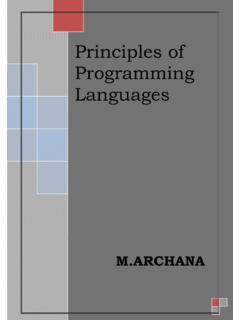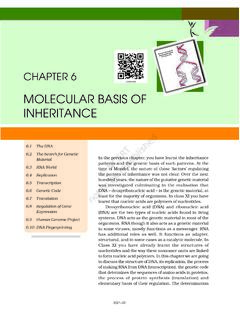Transcription of Principles of Programming Languages - CVR College of ...
1 Principles of Programming Languages 1 CONTENTS UNIT 1. PRELIMINARY CONCEPTS Reasons for Studying Concepts of Programming Languages Programming Domains , language Evaluation Criteria Influences on language Design, language Categories Programming Paradigms-Imperative , Functional Programming language language Implementation-compilation and interpretation Programming environments SYNTAX AND SEMANTICS The General Problems of Describing Syntax and semantics BNF EBNF for common Programming language features Ambiguous Grammar UNIT 2. DATA TYPES AND VARIABLES Introduction to Primitive Data Types User-Defined Data Types and Array Types Record,Union and Pointer and Reference types Names, Variables, The Concept of Binding Type Checking, Type Compatibility Strong Types, Named Constants,variable initialization EXPRESSIONS AND STATEMENTS & CONTROL STRUCTURES Expression: [Arithmetic, Relational and Boolean Expressions] Short-Circuit Evaluation Assignment Statements, Mixed-Mode Assignment [Referential Transparency & Functional Programming ] Control Structures [statement Level Control Structures, Compound statements] Selection Statements, Iterative Statements, Unconditional Branching, Guarded Commands UNIT 3.
2 SUBPROGRAMS AND BLOCKS Fundamentals of Subprograms Design Issues for Subprograms Parameter Passing Methods Parameters Subprograms as parameters Overloaded Subprograms & Operations Generic Subprograms,separately compiled modules Co-Routines 2 UNIT IV. ABSTRACT DATA TYPES Abstract -data types [Abstraction & Encapsulation] Introduction to Data Abstraction,Design Issues language Examples C++ Parameterized Abstract Data Types Data Types Object-Oriented Programming in Smalltalk Object-Oriented Programming in C++ Object-Oriented Programming in Java Object-Oriented Programming in C# Object-Oriented Programming in Ada 95 EXCEPTION HANDLING & LOGIC Programming Exception Handling:Exceptions, Exception Propagation Exception Handler in Ada C++ and Java Logic Programming language : Introduction An Overview of Logic Programming The Basic Elements of PROLOG Applications of Logic Programming UNIT-V.
3 FUNCTIONAL Programming Languages & SCRIPTING language Functional Programming language Introduction Fundamentals of Functional Programming Languages , LISP Programming Fundamentals of ML,examples Fundamentals of Haskell, function syntax and examples Applications of Functional Programing language and Comparison of Functional and Imperative Languages 3 CVR College OF ENGINEERING An UGC Autonomous Institution - Affiliated to JNTUH Unit-1, Unit-2,Unit-3, Unit-4 and Unit 5 Year and Semester: II yr & II Sem A Subject: Principles of Programming language Branch: CSE Faculty: , Assistant Professor (CSE) UNIT-1 Preliminary Concepts Background Frankly, we didn t have the vaguest idea how the thing [FORTRAN language and compiler] would work out in detail..We struck out simply to optimize the object program, the running time, because most people at that time believed you couldn t do that kind of thing.
4 They believed that machined-coded programs would be so inefficient that it would be impractical for many applications. John Backus, unexpected successes are common the browser is another example of an unexpected success Reasons for Studying Concepts of Programming Languages - CO1 Increased ability to express ideas Improved background for choosing appropriate Languages Increased ability to learn new Languages Better understanding of significance of implementation Overall advancement of computing Programming Domains CO1 Scientific applications Large number of floating point computations Fortran Business applications Produce reports, use decimal numbers and characters COBOL Artificial intelligence Symbols rather than numbers manipulated LISP Systems Programming Need efficiency because of continuous use C Web Software Eclectic collection of Languages .
5 Markup ( , XHTML), scripting ( , PHP), general-purpose ( , Java) 4 language Evaluation Criteria CO1, CO2 Readability : the ease with which programs can be read and understood Writability : the ease with which a language can be used to create programs Reliability : conformance to specifications ( , performs to its specifications) Cost : the ultimate total cost Readability Overall simplicity A manageable set of features and constructs Few feature multiplicity (means of doing the same operation) Minimal operator overloading Orthogonality A relatively small set of primitive constructs can be combined in a relatively small number of ways Every possible combination is legal Control statements The presence of well-known control structures ( , while statement) Data types and structures The presence of adequate facilities for defining data structures Syntax considerations Identifier forms: flexible composition Special words and methods of forming compound statements Form and meaning.
6 Self-descriptive constructs, meaningful keywords Writability Simplicity and Orthogonality Few constructs, a small number of primitives, a small set of rules for combining them Support for abstraction The ability to define and use complex structures or operations in ways that allow details to be ignored Expressivity A set of relatively convenient ways of specifying operations Example: the inclusion of for statement in many modern Languages Reliability Type checking Testing for type errors Exception handling Intercept run-time errors and take corrective measures Aliasing Presence of two or more distinct referencing methods for the same memory location Readability and writability A language that does not support natural ways of expressing an algorithm will necessarily use unnatural approaches, and hence reduced reliability Cost Training programmers to use language Writing programs (closeness to particular applications) Compiling programs Executing programs 5 language implementation system: availability of free compilers Reliability.
7 Poor reliability leads to high costs Maintaining programs Others Portability The ease with which programs can be moved from one implementation to another Generality The applicability to a wide range of applications Well-definedness The completeness and precision of the language s official definition 6 Influences on language Design - CO3 Computer Architecture Languages are developed around the prevalent computer architecture, known as the von Neumann architecture Programming Methodologies New software development methodologies ( , object-oriented software development) led to new Programming paradigms and by extension, new Programming Languages Computer Architecture Well-known computer architecture: Von Neumann Imperative Languages , most dominant, because of von Neumann computers Data and programs stored in memory Memory is separate from CPU Instructions and data are piped from memory to CPU Basis for imperative Languages Variables model memory cells Assignment statements model piping Iteration is efficient Figure The von Neumann Computer Architecture Programming Methodologies 1950s and early 1960s: Simple applications; worry about machine efficiency Late 1960s: People efficiency became important.
8 Readability, better control structures structured Programming top-down design and step-wise refinement Late 1970s: Process-oriented to data-oriented data abstraction Middle 1980s: Object-oriented Programming Data abstraction + inheritance + polymorphism 7 language Categories CO1 Imperative Central features are variables, assignment statements, and iteration Examples: C, Pascal Functional Main means of making computations is by applying functions to given parameters Examples: LISP, Scheme Logic Rule-based (rules are specified in no particular order) Example: Prolog Object-oriented Data abstraction, inheritance , late binding Examples: Java, C++ Markup New; not a Programming per se, but used to specify the layout of information in Web documents Examples: XHTML, XML language Design Trade-Offs Reliability vs.
9 Cost of execution Conflicting criteria Example: Java demands all references to array elements be checked for proper indexing but that leads to increased execution costs Readability vs. writability Another conflicting criteria Example: APL provides many powerful operators (and a large number of new symbols), allowing complex computations to be written in a compact program but at the cost of poor readability Writability (flexibility) vs. reliability Another conflicting criteria Example: C++ pointers are powerful and very flexible but not reliably used Implementation Methods -CO2 Compilation Programs are translated into machine language Pure Interpretation Programs are interpreted by another program known as an interpreter Hybrid Implementation Systems A compromise between compilers and pure interpreters Compilation Translate high-level program (source language ) into machine code (machine language ) Slow translation, fast execution Compilation process has several phases: lexical analysis: converts characters in the source program into lexical units syntax analysis: transforms lexical units into parse trees which represent the syntactic structure of program Semantics analysis.
10 Generate intermediate code code generation: machine code is generated 8 Figure Layered View of Computer: The operating system and language implementation are layered over Machine interface of a computer Figure The Compilation Process Additional Compilation Terminologies Load module (executable image): the user and system code together Linking and loading: the process of collecting system program and linking them to user program Execution of Machine Code Fetch-execute-cycle (on a von Neumann architecture) initialize the program counter repeat forever fetch the instruction pointed by the counter increment the counter decode the instruction execute the instruction end repeat Von Neumann Bottleneck Connection speed between a computer s memory and its processor determines the speed of a computer Program instructions often can be executed a lot faster than the above connection speed; the connection speed thus results in a bottleneck Known as von Neumann bottleneck.







